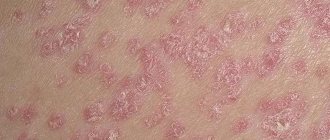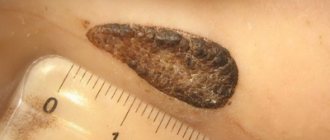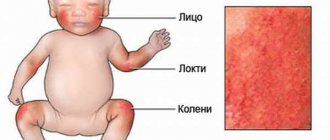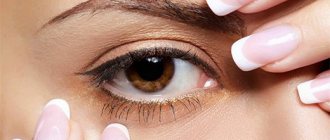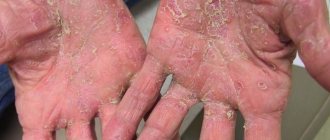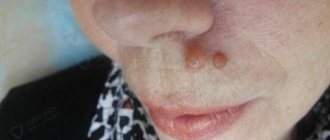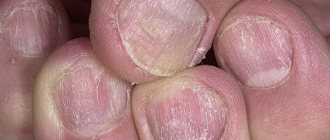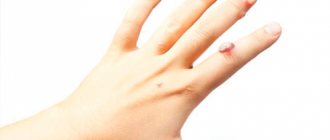Senile keratoma is a formation that is observed on the skin of exclusively elderly people and is a round papule up to several centimeters in diameter with hyperpigmentation and hyperkeratosis.
The first signs of the disease appear mainly after 50 years. In essence, age-related keratoma is a benign neoplasm.
The true reason that triggers the formation of the node has not been established. Doctors identify several factors that can influence changes in the epidermis
Single senile keratomas are observed extremely rarely; as a rule, the formations are multiple and located on different parts of the body: face, neck, palms.
There are no specific causes of senile keratoma; it is believed that there are certain risk factors for its occurrence, among them it is worth mentioning:
- Male gender. In men, multiple keratomas are observed much more often than in the fairer sex.
- Hereditary predisposition. If parents or other close blood relatives have the disease, the likelihood of developing senile keratosis increases sharply.
- Ultraviolet irradiation. The influence of UV rays is a factor in the formation of keratomas; it is believed that excessive exposure to sunlight can trigger the onset of the disease and be a factor in its progression.
- Lack of vitamin A. Unlike Kirle's disease, this factor plays a lesser role, however, even with multiple keratomas, treatment with retinol is often carried out.
Symptoms
The first manifestations of age-related keratoma are the appearance on the skin of open areas of the body (face, neck, palms, much less often on the torso) of oval or round spots that do not protrude above the surface of the skin. They have smooth, clear edges, at first they barely stand out as a darker color compared to the surrounding skin.
Over time, the spots darken, may increase in size, and their thickness also increases. A kind of wart is formed, which not only protrudes above the surface of the skin, but also acquires a characteristic roughness due to the growth of the stratum corneum of the epidermis.
Actinic keratosis is characterized by multiple formations, they are localized on the face, neck or palms, or spread throughout the body. The formations grow slowly and, when large, cause psychological discomfort, especially when localized on the face and neck.
Age-related keratomas protruding above the surface of the skin are easily injured. When the outer layer is damaged, the scales peel off, the capillary wall is destroyed, and slight capillary bleeding is observed, which also often causes inconvenience.
How to get rid of it?
It is impossible to prevent the development of actinic keratosis , but it is possible to stop the growth of skin growths.
How to remove skin tumors:
- traditional methods of therapy;
- use of medications: tablets and injections for warts;
- removing warts at home or in a clinic.
If you are planning to treat warts, then you should know:
- How to draw houses on your finger?
- How to get rid of hanging growths?
- Can warts go away on their own?
- Is it possible to cut them?
- Is it possible to remove growths, including during pregnancy?
- Is it possible and how to remove a wart in 1 day?
Or maybe you don’t have a wart at all? Then how to define it? And how is it different from papilloma? Find out more in our works.
Traditional therapy
If age-related keratomas appear, treatment with folk remedies can help.
- Potato compress . Grate the potatoes on a fine grater, place the pulp on the warts, and secure with a bandage. Change the bandage every hour for 3 - 4 hours. Potatoes can be replaced with crushed aloe leaves, Kalanchoe, and grated garlic.
- Plant juice . Mix garlic juice with honey (3:1), apply the mixture to the warts several times a day. Keratomas can also be treated with dandelion juice.
- Ammonia . Mix a pinch of flour with ammonia, apply the resulting cake to the skin growths on your hands, secure with a bandage. Apply once a day until disappearance.
You can get rid of warts at home by using:
- iodine;
- Castor oil;
- vinegar;
- celandine;
- as well as hydrogen peroxide;
- thread;
- and other means.
Medications
External hormonal drugs such as Advantan, Akriderm and Flucinar are prescribed exclusively by a doctor.
Their main goal is to reduce inflammation in pathological areas of the skin and reduce the growth of epidermal cells.
Taking large doses of ascorbic acid (vitamin C) prevents the formation of new keratomas.
Excessive intake of vitamin C into the body over a long period of time can lead to side effects : urolithiasis, stomach diseases.
Among the pharmaceutical remedies for warts you can also use:
- Freezing with nitrogen using Wartner Cryo or Cryopharma.
- Cauterization of skin growths using lapis pencil or SuperClandestine.
- Special patches such as Salipod.
- Ointments. We recommend trying Viferon.
Find more pharmacy and folk remedies for warts here.
Diagnostic measures for senile keratoma
The characteristic dynamics, the absence of complaints and the corresponding features of formations on the skin suggest a diagnosis of senile keratoma already upon examination.
To clarify the nature of the lesion, it is necessary to conduct dermatoscopy and ultrasound examination of the neoplasm. Senile keratoma must be differentiated from:
- nevi and melanoma (due to the proliferation of melanocytes and dark coloration);
- warts;
- papillomas;
- follicular keratoma;
- Bowen's disease and other chronic keratoses.
To make an accurate diagnosis, a histological examination is performed. It is performed only if a malignant process is suspected after all simpler diagnostic measures have been carried out:
- Inspection;
- Dermatoscopy and ultrasound examination.
If typical age-related keratomas are present, they are removed, after which histological examination is impossible.
Reasons for appearance
Unlike other warts, senile warts (keratomas) are not the result of damage to the body by papillomavirus . To date, scientists have not been able to establish the causes of the disease.
The reasons for the appearance of growths include:
- almost old age (40 - 50 years);
- metabolic disorders in the body;
- predisposition to oily seborrhea;
- avitaminosis;
- excess fatty foods in the diet;
- intense exposure to ultraviolet radiation on the skin.
If warts appear on your fingers and toes, then you should familiarize yourself with other causes.
Treatment
Drug treatment includes the use of ointment with solcoseryl. This method is resorted to only when the keratomas are clearly spread, and in the case of the presence of several formations, it is more reasonable to excise them.
At the same time, neither a conservative nor a surgical approach guarantees the absence of relapses of the disease. To prevent them, retinol therapy is used, but such treatment does not always provide the desired result.
Removal of keratomas is carried out in several ways:
- electrocoagulation – the tumor is completely removed due to coagulation of soft tissues, however, histological examination after this procedure is impossible, and therefore electrocoagulation is used only in the absence of signs of malignancy of the formation;
- cryodestruction does not allow radical removal of the entire keratoma, and after the use of liquid nitrogen, relapses are observed more often than after the use of other methods;
- radio wave excision is a method that allows you to completely remove the tumor, reduce the risk of relapse and reduce the likelihood of a postoperative scar, however, the method is not always available;
- Surgical treatment involves the formation of a scar at the site of excision of the formation, but is used in cases where a histological examination of the formation is necessary.
Traditional methods
You can cure senile pathology using folk remedies. If there are no contraindications after diagnostics, doctors recommend using herbal preparations that can be prepared at home:
To soften the keratinized node, compresses made from warm natural oils are used. Olive or sea buckthorn is suitable for this. The oil is heated to a comfortable temperature, then a soaked cotton swab is applied to the affected area and carefully sealed with an adhesive plaster.
Tincture of walnut fruits copes well with pathology. Pork fat lotions mixed with celandine improve skin condition, soften and eliminate itching.
Leaves are usually used. When a malignant process is detected, diagnostic studies are expanded. The patient undergoes MRI, CT, ultrasound of internal organs and a number of laboratory tests. Standard treatment includes chemotherapy, removal of the lesion, and radiation therapy.
Chemotherapy, administered intravenously, prevents cell division and reduces the volume of the tumor. Like radiation therapy, it is used in the pre- and postoperative period and as palliative treatment.
Classification
Seborrheic keratoma manifests itself as multiple formations
The following types of this disease are considered: seborrheic keratoma; senile; horny; solar; follicular. Solar keratoma is divided into the following subtypes: erythematous; papular; papillomatous; horny; pigmented; proliferative.
You cannot do anything on your own to eliminate this formation. Such actions can only aggravate the development of the pathological process, which will lead to serious complications. The forms of the disease are also distinguished based on their histological structure: spotted; nodular; plaque Mixed or transient forms may occur.
Seborrheic keratoma manifests itself as follows:
- formations are multiple, dark brown or black, varying in size;
- as the pathological process develops, the patient begins to experience itching and pain;
- the skin around the tumors may peel off;
- growths may fall off, which leads to the development of infections.
It should be noted that this form of keratoma can cause the development of an oncological process.
Senile keratoma manifests itself as follows: multiple neoplasms, often grouped together; the growths have a white or grayish tint and are often covered with plaques; localized on the neck and face; itching and peeling are extremely rare.
This form of keratoma can be diagnosed in people after 30 years of age. Horny keratoma fully corresponds to its name, it has the following shape: the growths have a dark shade, conical shape, which rises above the skin by 6–7 millimeters; the skin around the formation becomes red and may itch and burn. With this form of the disease, the neoplasm can also develop into a malignant form.
Follicular keratoma has the following symptoms:
- Follicular keratoma is represented by gray or pink nodules
gray or pink nodules;
- the diameter of the formations is no more than 2 centimeters;
- localized above the upper lip in the head area.
This form of the disease most often occurs in women and is not multiple in nature and rarely develops into a malignant tumor. The manifestation of solar keratoma is as follows:
- neoplasms are multiple in nature and are often grouped;
- localized in places that are exposed to sunlight (arms, legs, chest, part of the back);
- the surface of the neoplasms may become covered with scales; in rare cases, accompanied by itching.
It should be noted that this form of pathology is most often diagnosed in men after 40 years of age and can degenerate into a malignant formation. Transition to squamous cell skin cancer is most likely when traumatization of the formation and infection occurs.
Prevention
Preventive recommendations are as follows:
- when exposed to the sun for a long time, you should use protective cosmetics;
- The diet should include vegetables, fruits, and herbs;
- eliminate stress and strong nervous tension.
With the clinical manifestations described above, you should seek medical help and not ignore the symptom or attempt to independently eliminate the pathology.
